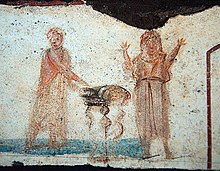
Back Roma katakombaları Azerbaijani Catacumbes romanes Catalan Římské katakomby Czech Katakomben in Rom German Κατακόμβες της Ρώμης Greek Catacumbas de Roma Spanish Rooman katakombit Finnish Catacombes de Rome French Rimske katakombe Croatian Római katakombák Hungarian
This article needs additional citations for verification. (April 2013) |

The Catacombs of Rome (Italian: Catacombe di Roma) are ancient catacombs, underground burial places in and around Rome, of which there are at least forty, some rediscovered only in recent decades.
Though most famous for Christian burials, either in separate catacombs or mixed together, Jews and also adherents of a variety of pagan Roman religions were buried in catacombs, beginning in the 2nd century AD,[1] occasioned by the ancient Roman ban on burials within a city, and also as a response to overcrowding and shortage of land. The most extensive and perhaps the best known is the Christian Catacomb of Callixtus located near the Park of the Caffarella, but there are other sites, both Christian and not, scattered around the city, some of which are now engulfed by modern urban sprawl.
The Christian catacombs are extremely important for the history of Early Christian art, as they contain the great majority of examples from before about 400 AD, in fresco and sculpture, as well as gold glass medallions (these, like most bodies, have been removed). The Jewish catacombs are similarly important for the study of Jewish culture at this early period.[2]

- ^ Toynbee: 39–40.
- ^ "Rome's Ancient Catacombs". National Geographic Society. 21 January 2017. Archived from the original on March 6, 2021.